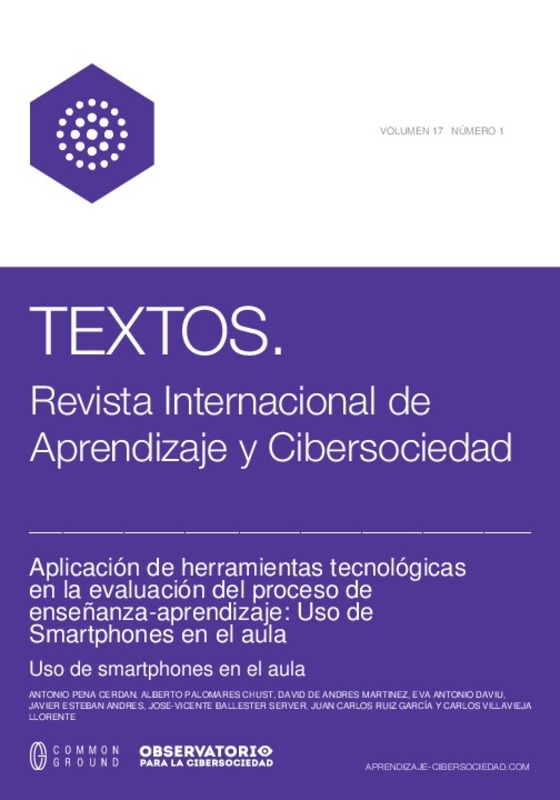|
Resumen:
|
[ES] El Equipo de Innovación y Calidad Educativa (EICE) “Tools and Strategies for Competences Assessment” (TASCA) de la Universitat Politècnica de València (UPV) tiene como objetivo básico investigar en metodologías que ...[+]
[ES] El Equipo de Innovación y Calidad Educativa (EICE) “Tools and Strategies for Competences Assessment” (TASCA) de la Universitat Politècnica de València (UPV) tiene como objetivo básico investigar en metodologías que ayuden a los profesores a evaluar, de manera inmediata, la asimilación de los contenidos didácticos impartidos en las clases para mejorar la docencia universitaria. Este trabajo se realiza en el marco del Proyecto de Innovación y Mejora Educativa (PIME) de la propia UPV “Apoyo a la Evaluación Formativa Presencial mediante el Diseño de Herramientas para la Obtención de Respuestas y Realimentación Inmediata en las Aulas” (A18/11). En este artículo se analiza el posible uso de los Smartphones de los alumnos para obtener esta realimentación inmediata de nuestra docencia en las clases. Esta propuesta está relacionada con el cambio de modelo productivo que está suponiendo para muchas empresas la aproximación conocida como “Bring Your Own Device” (BYOD), y es una alternativa mucho más económica a los denominados “Classroom/Student/Audience Response Systems” (ARS).
Desde el punto de vista pedagógico, hay que tener en cuenta los objetivos docentes y las competencias que se pretenden conseguir en cada aula, curso, carrera o disciplina, y las secuencias o pasos temporales en ese recorrido y, a partir de ahí, definir y planificar los tipos de pruebas, controles, cuestionarios o preguntas que se utilizarán para conseguir los resultados o reforzarlos. Desde el punto de vista tecnológico hay que diseñar las aplicaciones de soporte para su utilización ágil e inmediata en las aulas, y para poder hacerlo es necesario conocer las distintas plataformas y dispositivos tipo Smartphones existentes actualmente en el mercado, hay que determinar si los alumnos de nuestra Universidad disponen de dichos dispositivos, identificar las plataformas más comunes, e incluso analizar las posibles variaciones entre alumnos de distintas titulaciones. Para obtener esta información se ha diseñado y pasado una encuesta a alumnos de distintos cursos y titulaciones de la UPV. Otro aspecto importante del proyecto ha sido buscar soluciones integrables en la propia plataforma de e-learning de la UPV (PoliformaT, una instancia de SAKAI). Como resultado de todo este trabajo de investigación se ha desarrollado la arquitectura de la solución tecnológica que se propone en el artículo, y que permitirá explotar los Smartphone de los alumnos para enriquecer los servicios de e-learning de la UPV. Cabe señalar que el objetivo de este trabajo es poner la tecnología al servicio de la docencia, y utilizarla como una herramienta docente, y no como un fin en sí misma.
[-]
[EN] The main research interest of the Group for Education Innovation and Quality (EICE) "Tools and Strategies for Competences Assessment" (TASCA), from Universitat Politècnica de València (UPV), focuses on improving ...[+]
[EN] The main research interest of the Group for Education Innovation and Quality (EICE) "Tools and Strategies for Competences Assessment" (TASCA), from Universitat Politècnica de València (UPV), focuses on improving teaching at university level through the development of new methodologies to support teachers on quickly assessing the degree of assimilation of the didactic contents explained in the classroom. This work has been developed in the context of an Education Innovation and Improvement Project (PIME) of the UPV: "Supporting Face-to-Face Formative Assessment Through the Development of Tools for Answers Recollection and Fast Feedback in Classroom" (A18/11). This paper
studies the possibility of using student's smartphones to get this fast feedback of our daily teaching. This proposal is related to the change of the productive model that many enterprises are facing through the Bring Your Own Device (BYOD) approach, a cheaper alternative to the so called Classroom/Student/Audience
Response Systems (ARS). From a pedagogical perspective, it is necessary to take into account both the learning outcomes and competences that should be acquired in each course, year, or degree, and the timing along this trail and, from that point, define and schedule the types of tests or questionnaires that could be used to reach or reinforce the expected outcomes. From technological point of view, support applications are required for their fast and agile use in the classroom. To do so, it is necessary to study the different platforms and smartphone-like devices existing nowadays in the market, determine whether the students of UPV own any kind of these devices, identify the most commonly used platforms, and analyse the variations existing among students from different degrees. This information has been gathered through a poll distributed among students from different degrees, courses and schools of UPV. Another important aspect of the project is the search for solutions that could be integrated into UPV's own e-learning platform (PoliformaT, an instance of SAKAI). As a result of this research, this paper proposes an architecture for the technological solution that will enable the exploitation of student's smartphones to enrich the e-learning services of UPV. It must be noted that the main goal of this work is using technology as a teaching tool, and not as a goal in itself.
[-]
|







